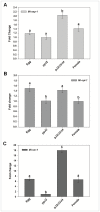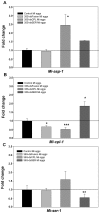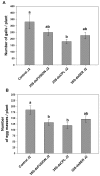Knocking-down Meloidogyne incognita proteases by plant-delivered dsRNA has negative pleiotropic effect on nematode vigor
- PMID: 24392004
- PMCID: PMC3877404
- DOI: 10.1371/journal.pone.0085364
Knocking-down Meloidogyne incognita proteases by plant-delivered dsRNA has negative pleiotropic effect on nematode vigor
Abstract
The root-knot nematode Meloidogyne incognita causes serious damage and yield losses in numerous important crops worldwide. Analysis of the M. incognita genome revealed a vast number of proteases belonging to five different catalytic classes. Several reports indicate that M. incognita proteases could play important roles in nematode parasitism, besides their function in ordinary digestion of giant cell contents for feeding. The precise roles of these proteins during parasitism however are still unknown, making them interesting targets for gene silencing to address protein function. In this study we have knocked-down an aspartic (Mi-asp-1), a serine (Mi-ser-1) and a cysteine protease (Mi-cpl-1) by RNAi interference to get an insight into the function of these enzymes during a host/nematode interaction. Tobacco lines expressing dsRNA for Mi-ser-1 (dsSER), Mi-cpl-1 (dsCPL) and for the three genes together (dsFusion) were generated. Histological analysis of galls did not show clear differences in giant cell morphology. Interestingly, nematodes that infected plants expressing dsRNA for proteases produced a reduced number of eggs. In addition, nematode progeny matured in dsSER plants had reduced success in egg hatching, while progeny resulting from dsCPL and dsFusion plants were less successful to infect wild-type host plants. Quantitative PCR analysis confirmed a reduction in transcripts for Mi-cpl-1 and Mi-ser-1 proteases. Our results indicate that these proteases are possibly involved in different processes throughout nematode development, like nutrition, reproduction and embryogenesis. A better understanding of nematode proteases and their possible role during a plant-nematode interaction might help to develop new tools for phytonematode control.
Conflict of interest statement
Figures







Similar articles
-
Host-induced RNA interference targeting the neuromotor gene FMRFamide-like peptide-14 (Mi-flp14) perturbs Meloidogyne incognita parasitic success in eggplant.Plant Cell Rep. 2024 Jun 22;43(7):178. doi: 10.1007/s00299-024-03259-y. Plant Cell Rep. 2024. PMID: 38907748
-
Host-delivered RNAi-mediated silencing using fusion cassettes of different functional groups of genes precludes Meloidogyne incognita multiplication in Nicotiana tabacum.Plant Cell Rep. 2023 Jan;42(1):29-43. doi: 10.1007/s00299-022-02934-2. Epub 2022 Dec 3. Plant Cell Rep. 2023. PMID: 36462028
-
Knock-down of heat-shock protein 90 and isocitrate lyase gene expression reduced root-knot nematode reproduction.Phytopathology. 2015 May;105(5):628-37. doi: 10.1094/PHYTO-09-14-0237-R. Phytopathology. 2015. PMID: 26020830
-
Host-mediated RNAi for simultaneous silencing of different functional groups of genes in Meloidogyne incognita using fusion cassettes in Nicotiana tabacum.Plant Cell Rep. 2021 Dec;40(12):2287-2302. doi: 10.1007/s00299-021-02767-5. Epub 2021 Aug 13. Plant Cell Rep. 2021. PMID: 34387737
-
In planta RNAi approach targeting three M. incognita effector genes disturbed the process of infection and reduced plant susceptibility.Exp Parasitol. 2022 Jul;238:108246. doi: 10.1016/j.exppara.2022.108246. Epub 2022 Apr 20. Exp Parasitol. 2022. PMID: 35460697
Cited by
-
Host-Induced Silencing of Two Pharyngeal Gland Genes Conferred Transcriptional Alteration of Cell Wall-Modifying Enzymes of Meloidogyne incognita vis-à-vis Perturbed Nematode Infectivity in Eggplant.Front Plant Sci. 2017 Mar 30;8:473. doi: 10.3389/fpls.2017.00473. eCollection 2017. Front Plant Sci. 2017. PMID: 28424727 Free PMC article.
-
A new fungus-mediated RNAi method established and used to study the fatty acid and retinol binding protein function of the plant-parasitic nematode Aphelenchoides besseyi.RNA Biol. 2021 Oct;18(10):1424-1433. doi: 10.1080/15476286.2020.1852779. Epub 2020 Dec 14. RNA Biol. 2021. PMID: 33218290 Free PMC article.
-
Chitin Biosynthesis Inhibition of Meloidogyne incognita by RNAi-Mediated Gene Silencing Increases Resistance to Transgenic Tobacco Plants.Int J Mol Sci. 2020 Sep 10;21(18):6626. doi: 10.3390/ijms21186626. Int J Mol Sci. 2020. PMID: 32927773 Free PMC article.
-
Transcriptome analysis of Globodera pallida from the susceptible host Solanum tuberosum or the resistant plant Solanum sisymbriifolium.Sci Rep. 2019 Sep 13;9(1):13256. doi: 10.1038/s41598-019-49725-6. Sci Rep. 2019. PMID: 31519937 Free PMC article.
-
Selenium Nanoparticles-an Inducer of Tomato Resistance to the Root-Knot Nematode Meloidogyne incognita (Kofoid et White, 1919) Chitwood 1949.Dokl Biochem Biophys. 2018 Sep;482(1):264-267. doi: 10.1134/S1607672918050095. Epub 2018 Nov 5. Dokl Biochem Biophys. 2018. PMID: 30397889
References
-
- Souza DS, de Souza JDA Jr., Grossi-de-Sá M, Rocha TL, Fragoso RR et al. (2011) Ectopic expression of a Meloidogyne incognita dorsal gland protein in tobacco accelerates the formation of the nematode feeding site. Plant Sci 180: 276-282. doi:10.1016/j.plantsci.2010.09.003. PubMed: 21421371. - DOI - PubMed
Publication types
MeSH terms
Substances
LinkOut - more resources
Full Text Sources
Other Literature Sources

